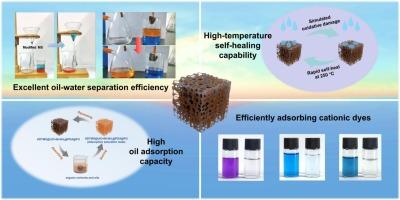仿生叶蜡层自愈超疏水MOF海绵,具有双重用途:高容量吸油和高效阳离子染料去除
IF 5.1
3区 工程技术
Q1 CHEMISTRY, APPLIED
引用次数: 0
摘要
在这项工作中,制备了一种多功能仿生自愈超疏水MOF海绵(HDTMS@UiO-66-NH2@PDA@MS),用于高效分离油水和去除阳离子染料废水。通过DA氧化和自聚合在三聚氰胺海绵表面形成PDA层,并将UiO-66-NH2负载在三聚氰胺海绵表面。为了进一步增强MOF海绵的疏水性,将十六烷基三甲氧基硅烷(HDTMS)水解缩聚,在海绵表面形成一层无毒的低表面能聚硅氧烷胶粘剂。所制备的改性海绵具有优异的超疏水性(水接触角为156.2°),高吸油量(73.2 ~ 164.7 g/g),阳离子染料去除率(大于95%)。受植物叶片蜡层自愈机制的启发,改性海绵在模拟氧化损伤后,可在250℃下实现快速自愈。此外,优异的油水分离效率、可重复使用性、环境稳定性和自清洁能力的协同效应使HDTMS@UiO-66-NH2@PDA@MS成为海洋溢油修复和含油废水处理的有希望的候选者。本文章由计算机程序翻译,如有差异,请以英文原文为准。

Biomimetic leaf wax layer self-healing superhydrophobic MOF sponge with dual applications: High-capacity oil adsorption and efficient cationic dye elimination
In this work, a multifunctional biomimetic self-healing superhydrophobic MOF sponge (HDTMS@UiO-66-NH2@PDA@MS) was prepared for efficient oil-water separation and cationic dye wastewater removal. A PDA layer was formed on the surface of the sponge by DA oxidation and self-polymerization, and UiO-66-NH2 was loaded onto the melamine sponge. To further enhance the hydrophobic properties of the MOF sponge, cetyltrimethoxysilane (HDTMS) is hydrolyzed and condensed to form a non-toxic layer of low surface energy polysiloxane adhesive on the surface of the sponge. The prepared modified sponge exhibited excellent superhydrophobicity (water contact angle of 156.2°), high oil adsorption capacity (73.2–164.7 g/g), and cationic dye removal rate (more than 95 %). Inspired by the self-heal mechanism of the wax layer on plant leaves, the modified sponge and can achieve rapid self-heal at 250 °C after simulated oxidative damage. In addition, the synergistic effects of excellent oil-water separation efficiency, reusability, environmental stability, self-cleaning capabilities make HDTMS@UiO-66-NH2@PDA@MS a promising candidate for marine oil spill remediation and oily wastewater treatment.
求助全文
通过发布文献求助,成功后即可免费获取论文全文。
去求助
来源期刊

Reactive & Functional Polymers
工程技术-高分子科学
CiteScore
8.90
自引率
5.90%
发文量
259
审稿时长
27 days
期刊介绍:
Reactive & Functional Polymers provides a forum to disseminate original ideas, concepts and developments in the science and technology of polymers with functional groups, which impart specific chemical reactivity or physical, chemical, structural, biological, and pharmacological functionality. The scope covers organic polymers, acting for instance as reagents, catalysts, templates, ion-exchangers, selective sorbents, chelating or antimicrobial agents, drug carriers, sensors, membranes, and hydrogels. This also includes reactive cross-linkable prepolymers and high-performance thermosetting polymers, natural or degradable polymers, conducting polymers, and porous polymers.
Original research articles must contain thorough molecular and material characterization data on synthesis of the above polymers in combination with their applications. Applications include but are not limited to catalysis, water or effluent treatment, separations and recovery, electronics and information storage, energy conversion, encapsulation, or adhesion.
 求助内容:
求助内容: 应助结果提醒方式:
应助结果提醒方式:


